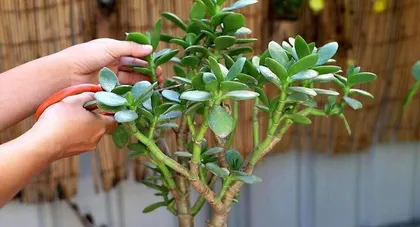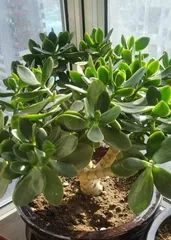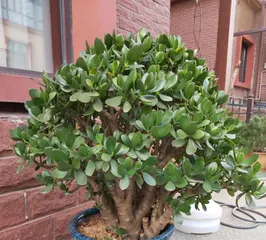The Jade Plant is a common indoor foliage plant that not only beautifies the home environment but also has certain air-purifying functions. However, there has been ongoing debate about whether the Jade Plant is toxic. This article will guide you through the toxicity of the Jade Plant and related care tips, allowing you to grow it at home with more peace of mind.

I. Classification and Characteristics of the Jade Plant
The Jade Plant is a type of succulent belonging to the genus *Ficus* in the family Moraceae. It grows rapidly, with lush branches and leaves, and comes in various forms. In China, it is widely distributed in the southern provinces and has good adaptability and vitality.
II. Analysis of the Jade Plant's Toxicity
Although some people believe the Jade Plant is toxic, this has not been confirmed by scientific research. Nevertheless, during care, it is still important to note the following: it should not be eaten, gloves should be worn when handling it, and contact with pregnant women and children should be avoided.

III. Cultivation Tips for the Jade Plant
1. Choose a suitable container: Generally, for Jade Plants with more fleshy leaves, it is suitable to plant them in wide, shallow pots.
2. Water moderately: The Jade Plant should not be overwatered. Each watering should be just enough to moisten the soil without water leaking from the bottom.
3. Avoid direct sunlight and cold: Avoid exposure to intense sun and cold weather, and maintain a suitable temperature and humidity environment.

4. Regular fertilization: Spring and autumn are the growing seasons for the Jade Plant. You can apply base fertilizer and top-dressing appropriately, but not excessively.
IV. Introduction to Common Jade Plant Varieties
1. *Crassula ovata* (Jade Plant): It has thick, fleshy leaves with a glossy color, sturdy petioles, and slender branches, revealing the plant's aesthetic beauty.
2. *Ficus pumila* (Creeping Fig): It has green leaves with distinct hairy edges, and its twisting branches create a good visual effect.
3. *Crassula ovata 'Gollum'* (Shrek's Ears): The potted plant can reach a height of 1 meter. Its young leaves have a reddish tint, turning dark green as they mature, with a unique shape.
V. Medicinal Value of the Jade Plant
The Jade Plant also has certain medicinal values, mainly in clearing heat and detoxifying, promoting diuresis to reduce swelling, and anti-inflammatory and detoxifying effects. However, it is generally not recommended to use the Jade Plant for medicinal purposes at home without professional guidance.
VI. Common Jade Plant Pests, Diseases, and Control Methods
1. Yellowing leaves: This may be caused by malnutrition, such as nitrogen or iron deficiency. Appropriate fertilizer should be supplemented in a timely manner.
2. Blackening leaves: This may be caused by overwatering or poor ventilation. The amount of water should be adjusted, and ventilation should be increased.
3. Pests on leaves: Control can be carried out by spraying pesticides or manually removing the pests.
VII. Precautions for Jade Plant Care
1. Environmental conditions: Maintain suitable temperature, humidity, and light conditions, and avoid sudden changes.
2. Clean the leaves: Regularly wipe dust and dirt off the leaves with a damp cloth.
3. Regular pruning: Prune excess branches, leaves, and overgrown parts in a timely manner to maintain a neat plant shape.
4. Prevent contamination: Avoid polluting the soil and plant with fertilizers, pesticides, etc.
5. Pay attention to planting methods: Different Jade Plant varieties require different planting methods; pay attention to their adaptability.
VIII. Jade Plant Varieties Suitable for Home Placement
1. *Crassula ovata* (Common Jade Plant): It has thick leaves and is not prone to disease, making it suitable for placement in indoor balconies, living rooms, and other locations.
2. *Ficus pumila* (Creeping Fig): It has good ornamental value and air-purifying functions, making it suitable for placement in studies and other areas.
3. *Crassula ovata 'Gollum'* (Shrek's Ears): It has slender branches and is suitable for placing in corners or on desktops as a decorative item.
IX. How to Choose a Healthy Jade Plant
1. Observe the plant: When purchasing, observe whether the plant is healthy and free from pests and diseases.
2. Observe the root system: Check if the roots are healthy and avoid purchasing plants with pathogens.
3. Observe the leaves: When purchasing, pay attention to whether the leaves are intact and have a vibrant color.
X. How to Safely Care for a Jade Plant
1. Avoid contact: Wear gloves when handling the Jade Plant to prevent skin irritation.
2. Water regularly: Water the Jade Plant regularly, paying attention to controlling the amount and frequency to avoid overwatering.
3. Ensure ventilation: Maintain air circulation to avoid overly humid and stuffy environments.
4. Avoid over-fertilizing: The amount of fertilizer each time should not be excessive to avoid adverse effects on the plant.
XI. Suitable Temperature and Humidity for the Jade Plant
1. Suitable temperature: The suitable temperature for the Jade Plant to grow is 15°C to 28°C. In summer, avoid exposure to intense sunlight.
2. Suitable humidity: The suitable humidity for the Jade Plant to grow is 60% to 80%. Humidity that is too high or too low will affect the plant's growth.
XII. Pairing the Jade Plant with Other Plants
1. Pairing with cacti: Pairing the Jade Plant with cacti can help increase indoor air humidity.
2. Pairing with Monstera: Pairing the Jade Plant with Monstera can create a fresh and natural home environment.
XIII. Solutions to Common Jade Plant Care Problems
1. Why is the Jade Plant growing poorly? This may be due to unsuitable environmental conditions or malnutrition. Adjustments should be made in a timely manner.
2. Why are the Jade Plant's leaves turning yellow? This may be caused by malnutrition, such as nitrogen or iron deficiency. The corresponding nutrients should be supplemented in a timely manner.
3. Why are the Jade Plant's leaves withering? This may be caused by underwatering or overwatering. The amount and frequency of watering should be adjusted in a timely manner.
XIV. How to Handle the Jade Plant's New Shoots
During the shooting stage, propagation can be done by transplanting or cutting. When transplanting, pay attention to protecting the root system. When cutting, pay attention to treating the cut surface.
XV.
In summary, the Jade Plant has not been proven to be toxic, but it is still necessary to pay attention to related matters during its care. Choosing a suitable variety, using reasonable planting methods, fertilizing regularly, and avoiding overwatering can all effectively protect the growth of the Jade Plant.